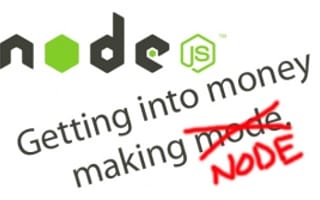Imagine if the entire planet could speak a “global” common language. Sure, there would still be other languages, but everyone could speak the “global” language. Even in the most remote jungle tribes could speak it. What would life be like? Now, imagine if we had just ONE computer language most developers knew to complete an end-to-end application build. This means one developer could get the language rendered on the server AND the client. Well, something like this now exists in the JavaScript world. It now allows somebody to render the application markup on the server and push it out as functional HTML to the browser. In the software programming world, this is called Universal JavaScript, or more formally known as Isomorphic JavaScript (Uhm, yeah, that sounds like a brand of gloves.). In the language of dollars and cents, it is something with a tremendous long term upside in regards to reduced development costs, maintenance costs, training costs,...etc. When we are talking about getting more bang for the buck, does this often get an investor’s attention? You bet.
Node kidding aside...
Let’s face it, computer languages are not often the center of discussion when it comes to start-up investors. It is just another tool in the business toolbox. As expected, the center of the conversation is often on the business, product, and financial info...and every investor’s favorite question, “How soon can I get my money back with solid CAGR and positive EBITDA?” So, the likely hood of a single computer language getting the attention is slim. Especially since today’s technology stacks are polyglotic (but not polyester!...sorry, it's been a long day.) with many different languages being used. But, for savvy investors, if a language can bring long term savings, ease in hiring, easier maintenance, and faster time to market for a start-up, it is worth honorable mention.
So, what is behind this Isomorphic JavaScript we are talking about here? It is a derived language of JavaScript called Node.js (Let’s call it “Node” for short). It is a language in itself, but written from JavaScript. Those familiar with JavaScript now have a pathway to do back-end programming via Node. Node is the new kid on the block when compared to other back-end languages like Java, Ruby, PHP and Python. As Node matures, something is becoming more clear: It is not going away anytime soon. Last year, the motives to form a neutral Node.js Foundation was announced. So, why all the attention on Node from outside the development community? The short answer is: Economics. We will get to that in a moment, but first a little history.
Okay, what is this Node.js stuff all about?...elevator version.
Node was created in in 2009 by Ryan Dahl. His original motivation was not to create a global language, but rather solve a file loading problem he encountered. As mentioned earlier, he created the language from JavaScript. JavaScript is the language of the Web, and almost every application programmer, Web designer, and Web developer knows the language. It is arguably the most popular language used today. When it comes to controlling the behavior of a single Web page running in a browser, JavaScript pretty much owns the world. But, JavaScript has long been limited to just the browser environment. In so many words at a high level, Node gives JavaScript back-end capability. When we are talking Node, there are usually four strengths always mentioned:
1. The programming model is event driven, especially the way it handles I/O.
2. It can be easily used to create concurrent server applications, running as multi-thread.
3. It uses JavaScript and the parser is Google’s V8 JS engine.
4. It is ridiculously fast running on V8 compared to many other back-end languages.
This is all cool stuff, and very powerful for the development community. However, this is not the intrigue of investors with respect to the economics of Node. In regards to economics, here is what is driving the discussion...
A Shift in the development staffing paradigm?
With so many folks knowing JavaScript, it opens the door to a much larger pool of resources to do a job typically more dedicated to developers of other languages. This means an opportunity for operational savings. We are talking a consolidation of skills. Using just ONE language to carry more of the tasks without a cross-compiler. The rates are less for a JavaScript developer versus a Python, Ruby, C# or PHP programmer who is a full stack developer. JavaScript developer rates are less because there are many more people who know the language. It also, reduces the amount of search time for developers. For example, finding a savvy full-stack Python/Django developer is more of a mountain climb versus a search for a savvy JavaScript developer. Economically, JavaScript wins this round. However, I know there are recruiters out there who are already putting their face in their palms as they read this section. Why? Answer: Isomorphic JavaScript potentially further heightens the issue of roles and rates. As an example, consider a front-end Graphic Designer who knows a little JavaScript. They may get pushed by an “overly frugal” client into situations that really needs a JavaScript developer. In this case, we now have a situation of a Graphic Designer possibly being asked to take a look at a back-end issue running on Node with the client thinking, “Hey, it’s just JavaScript, can’t you work on that too?” The Graphic Designer ends up with the short end as their rate is not reflecting the additional JavaScript work. Plus, this is not their core skill. This further highlights that role definitions for resources needs to be in place. In analogy, just because a chef can use a gas torch to caramelize crème brulee, does not mean they can gas solder copper plumbing. In other words, the restaurant owner should not expect the chef to fix the plumbing in the kitchen too. Hire a plumber.
Where are the bigger software players headed with Node?
As you might expect, some big players and projects are switching to Node like: LinkedIn, Flickr, PayPal, Quad, Yahoo, InKlout, Microsoft, duckduckgo.com, and Oracle. They want in on the action. They acknowledge the future economics of Isomorphic JavaScript being an impact, and they are placing investment into Node. As an example of actions speaking, take a look at Oracle's recent Chicago Oracle Hackathon. The company is trying to attract key tech development communities like Austin, Chicago, and San Francisco to explore cloud native web application development using Node to get first-hand experience with Oracle Public Cloud. If you are thinking, wait a minute...doesn’t Oracle own the well established Java language? There are tons of Java programmers, and good rates that can already be found. Why are they not promoting Java with their new product portfolio? In truth, the company has come under fire for their alleged negligence of the Java language. There is an outright mutiny occurring with Oracle and the Java development community withJava EE devotees plotting to seize control from Oracle. If there was a tech version of TMZ, they would surely be all over this scoop.
The next steps for Node.js
Node is still a young language. Like all newer languages, it still needs time to get through the maturity curve with things such as security, support, various run-time issues, and simply more people using it. Will it truly have staying power for many years to come? Time will only tell. However, the sheer concept of an isomorphic language has intrigue for many beyond the development community itself. It carries tremendous potential economic advantages in the form of staffing and support. Again, something of interest to anyone investing for longer term merits.
---------------------------------------------------------------
About The Author:
Brad Beiermann is a nationally recognized technology executive, author, and speaker with specialization in e-commerce, Agile, mobile, and start-ups such as Cimstrat.com, ProfessorString.com, HienoteDirectory.com, and others. He has considerable experience as a digital technology management consultant with Fortune 500 companies and the entrepreneurial community. He can be reached at bradb at cimstrat dot com.






